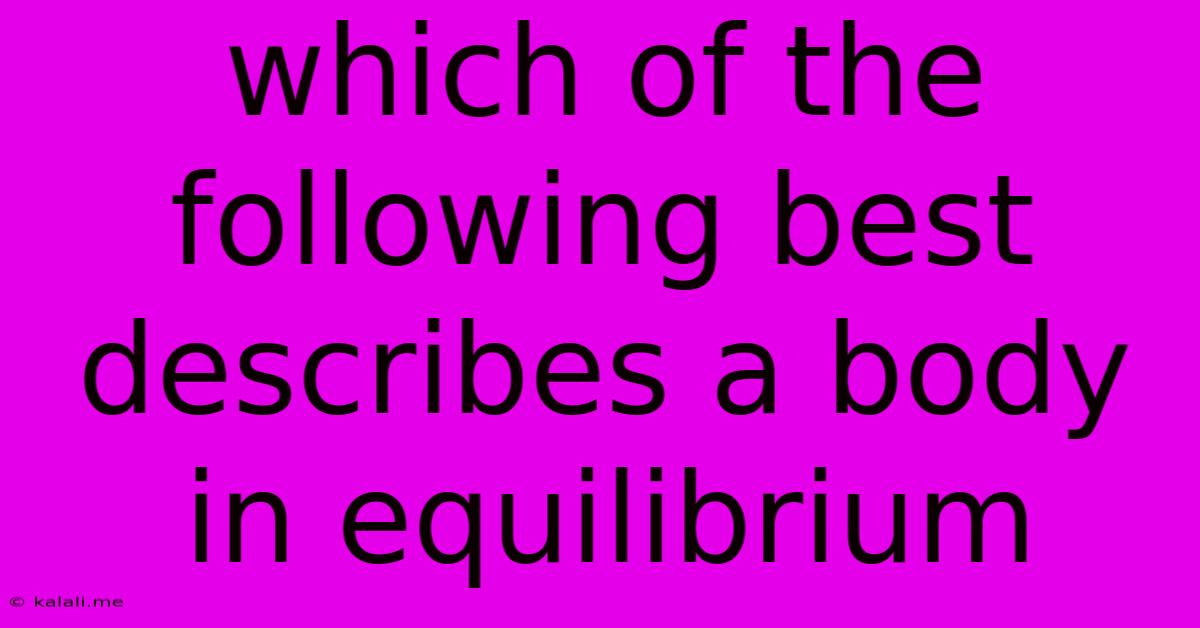Which Of The Following Best Describes A Body In Equilibrium
Kalali
Jun 16, 2025 · 3 min read

Table of Contents
Which of the Following Best Describes a Body in Equilibrium? Understanding Static and Dynamic Equilibrium
Understanding equilibrium is crucial in physics and engineering. A body in equilibrium is one where all the forces and torques acting upon it are balanced, resulting in no net change in its motion. But what exactly does that mean? Let's delve into the different types of equilibrium and determine which best describes a body in this state. This article will explore the nuances of static and dynamic equilibrium, clarifying the key differences and providing real-world examples.
What is Equilibrium?
In simple terms, equilibrium means a state of balance. For a body to be in equilibrium, two fundamental conditions must be met:
-
Translational Equilibrium: The net force acting on the body must be zero. This means that all forces acting on the object must cancel each other out. Think of it like a tug-of-war where neither side is winning – the forces are perfectly balanced.
-
Rotational Equilibrium: The net torque acting on the body must be zero. Torque is a measure of how much a force tends to rotate an object around an axis. For rotational equilibrium, the clockwise torques must equal the counter-clockwise torques. Imagine a perfectly balanced seesaw; the torques from each side are equal and opposite.
Types of Equilibrium:
There are two main types of equilibrium:
-
Static Equilibrium: A body in static equilibrium is at rest. All forces and torques acting on it are balanced, and its velocity and acceleration are both zero. A book resting on a table is a classic example of static equilibrium. The gravitational force pulling the book down is balanced by the normal force from the table pushing it up.
-
Dynamic Equilibrium: A body in dynamic equilibrium is moving, but at a constant velocity. The net force and net torque are still zero, meaning there's no change in its motion. A car driving at a constant speed on a straight road is a good example. The engine's force is balanced by air resistance and friction, resulting in no acceleration.
Which Best Describes a Body in Equilibrium?
The best description depends on the context. Both static and dynamic equilibrium satisfy the conditions of zero net force and zero net torque. The difference lies in the object's velocity: zero for static equilibrium, constant non-zero for dynamic equilibrium.
Therefore, the answer isn't a simple choice between "static" and "dynamic". A complete answer would be: A body in equilibrium is described by both the absence of net force (translational equilibrium) and the absence of net torque (rotational equilibrium), which can manifest as either static or dynamic equilibrium depending on whether the body is at rest or moving with constant velocity.
Examples Illustrating the Concepts:
- Static Equilibrium: A hanging picture, a balanced mobile, a bridge at rest.
- Dynamic Equilibrium: A skydiver reaching terminal velocity, a satellite orbiting the Earth at a constant speed, a plane cruising at a constant altitude and speed.
Understanding the difference between static and dynamic equilibrium allows for better analysis of various physical systems and the forces acting upon them. This knowledge is fundamental in fields like structural engineering, mechanics, and aerospace engineering. By correctly identifying the type of equilibrium present, one can accurately predict the behavior of the system.
Latest Posts
Latest Posts
-
How To Create Clickable Image In Html
Jun 16, 2025
-
What Are The Factors Of 121
Jun 16, 2025
-
What Is A Theme Of The Passage
Jun 16, 2025
-
A Company That Provides Access To The Internet
Jun 16, 2025
-
Which Word Is Closest In Meaning To The Underlined Word
Jun 16, 2025
Related Post
Thank you for visiting our website which covers about Which Of The Following Best Describes A Body In Equilibrium . We hope the information provided has been useful to you. Feel free to contact us if you have any questions or need further assistance. See you next time and don't miss to bookmark.